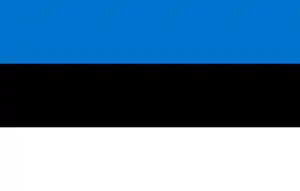Estonian Australians
Estonian Australians (Estonian: Austraalia eestlased) refers to Australian citizens of Estonian descent or Estonia-born persons who reside in Australia. According to the 2011 Census, there were 8,551 people of Estonian descent in Australia and 1,928 Estonia-born people residing in the country at the moment of the census, having a fall of 0.4 per cent compared to the 2006 Census. The largest Estonia-born community in Australia is in the state of New South Wales, with 731 people.[1]
| Total population | |
|---|---|
| 1,928 (by birth, 2011 Census)[1] 8,551 (by ancestry, 2011 Census)[1] | |
| Regions with significant populations | |
| Estonia-born people by state or territory | |
| New South Wales | 731[1] |
| Victoria | 365[1] |
| Queensland | 290[1] |
| Western Australia | 240[1] |
| Languages | |
| Australian English · Estonian | |
| Religion | |
| Christianity (Predominantly Lutheranism) | |
| Related ethnic groups | |
| Finnish Australians | |
From 1940 to 1944, more than 70,000 Estonians fled to the West due to the Soviet and German occupations. Many settled in Australia.[2] The first voyage under Arthur Calwell's Displaced Persons immigration program, that of the General Stuart Heintzelman in 1947,[3] was specially chosen to be all from Baltic nations, all single, many blond and blue-eyed, in order to appeal to the Australian public.[4] Of the 843 immigrants on the Heintzelman, 142 were Estonian.[5]
Notable people
- Anna Murdoch Mann, second wife of Rupert Murdoch
- Armin Öpik, geologist
- Arvi Parbo, chairman of BHP
- Vicki Viidikas, poet
- Dane Rampe, AFL player for the Sydney Swans
- Erik Paartalu, professional footballer
See also
External links
References
- "The Estonia-born Community". Australian Government Department of Immigration. 19 November 2003. Archived from the original on 13 February 2014. Retrieved 22 January 2014.
- "Our new home: Estonian-Australian stories". migrationheritage.nsw.gov.au. 2007. Archived from the original on 5 September 2007.
- "First of the Fifth Fleet". Retrieved 22 February 2017.
- J. Franklin, Calwell, Catholicism and the origins of multicultural Australia, Proc. of the Australian Catholic Historical Society 2009 Conference, 42-54.
- "Immigrant Ships Transcribers Guild: USAT General Stuart Heintzelman". Retrieved 27 February 2017.
